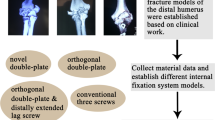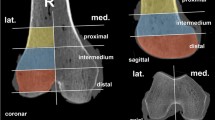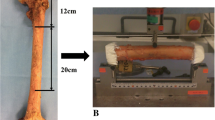Abstract
Introduction
Working hypothesis: The distal humeral bone density influences supracondylar fracture threshold. The aim of this study was first to develop a reproducible model of intra-articular distal humeral fractures and second to establish a relationship between bone mineral density (BMD) and the fracture threshold of the humerus.
Materials and methods
An original model of the fracture was developed using ten sawbones. After obtaining a reproducible and clinically relevant fracture model, we tested 21 cadaveric distal humeri for which the BMD was known with a stainless-steel custom-made proximal ulna jig. Fractures were created using a servo hydraulic-testing machine in axial compression to simulate a fall onto an outstretched hand. Fracture lines, load to failure, and rigidity of the bone were recorded based on the stress-strain curves.
Results
The fracture generation was reliable, reproducible, and clinically relevant (type B2). A significant correlation between the BMD and the fracture threshold was found. Mean threshold was 901.86 N/m2. Mean distal humerus BMD was 0.9097 g/cm2 (r = 0.7321).
Conclusions
We developed a reproducible articular fracture of the distal humerus model and found a correlation between the fracture threshold and bone mineral density.


Similar content being viewed by others
References
Lippuner K, Johansson H, Kanis J, Rizzoli R (2009) Remaining lifetime and absolute 10-year probabilities of osteoporotic fracture in Swiss men and women. Osteoporos Int 20(7):1131–1140. https://doi.org/10.1007/s00198-008-0779-8
Pidhorz L, Alligand-Perrin P, De Keating E, Fabre T, Mansat P, (SoFCOT). Sfdcoet (2013) Distal humerus fracture in the elderly: does conservative treatment still have a role? Orthop Traumatol Surg Res 99(8):903–907. https://doi.org/10.1016/j.otsr.2013.10.001
Clavert P, Ducrot G, Sirveaux F, Fabre T, Mansat P, SOFCOT (2013) Outcomes of distal humerus fractures in patients above 65 years of age treated by plate fixation. Orthop Taumatol Surg Res 99(7):771–777. https://doi.org/10.1016/j.otsr.2013.08.001
Mansat P, Nouaille Degorce H, Bonnevialle N, Demezon H, Fabre T, SOFCOT (2013) Total elbow arthroplasty for acute distal humeral fractures in patients over 65 years old - results of a multicenter study in 87 patients. Orthop Taumatol Surg Res 99(7):779–784. https://doi.org/10.1016/j.otsr.2013.08.003
Clavert P, Javier R, Charrissoux J, Obert L, Pidhorz L, Sirveaux F, Mansat P, Fabre T (2016) How to determine the bone mineral density of the distal humerus with radiographic tools? Surg Radiol Anat 38(4):389–393. https://doi.org/10.1007/s00276-015-1569-6
Augat P, Schorlemmer S (2006) The role of cortical bone and its microstructure in bone strength. Age Ageing 35(Suppl 2):ii27–ii31. https://doi.org/10.1093/ageing/afl081
Goldfarb C, Patterson J, Sutter M, Krauss M, Steffen J, Galatz L (2012) Elbow radiographic anatomy: measurement techniques and normative data. J Shoulder Elb Surg 21(9):1236–1246. https://doi.org/10.1016/j.jse.2011.10.026
O'Driscoll S, Morrey B, An K (1990) Intraarticular pressure and capacity of the elbow. Arthroscopy 6(2):100–103. https://doi.org/10.1016/0749-8063(90)90007-z
Rüedi T, Buckley R, Moran C (2007) AO principles of fracture management. Thieme, Stuttgart
Shimamura Y, Nishida K, Imatani J, Noda T, Hashizume H, Ohtsuka A, Ozaki T (2010) Biomechanical evaluation of the fixation methods for transcondylar fracture of the humerus:ONI plate versus conventional plates and screws. Acta Med Okayama 64(2):115–120. https://doi.org/10.18926/AMO/32855
Windolf M, Maza E, Gueorguiev B, Braunstein V, Schwieger K (2010) Treatment of distal humeral fractures using conventional implants. Biomechanical evaluation of a new implant configuration. BMC Musculoskelet Disord 4(11):172. https://doi.org/10.1186/1471-2474-11-172
Kollias C, Darcy S, Reed J, Rosvold J, Shrive N, Hildebrand K (2010) Distal humerus internal fixation: a biomechanical comparison of 90° and parallel constructs. Am J Orthop (Belle Mead NJ) 39(9):440–444
Author information
Authors and Affiliations
Corresponding author
Ethics declarations
Conflict of interest
The authors declare that they have no conflict of interest.
Additional information
Publisher’s note
Springer Nature remains neutral with regard to jurisdictional claims in published maps and institutional affiliations.
Rights and permissions
About this article
Cite this article
Marcoin, A., Eichler, D., Kempf, JF. et al. Biomechanical model of distal articular humeral fractures—influence of bone density on the fracture threshold. International Orthopaedics (SICOT) 44, 1385–1389 (2020). https://doi.org/10.1007/s00264-020-04624-8
Received:
Accepted:
Published:
Issue Date:
DOI: https://doi.org/10.1007/s00264-020-04624-8




